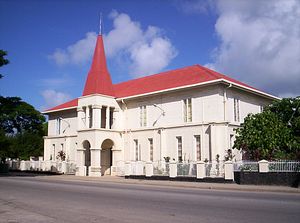The fate of the Pacific Agreement on Closer Economic Relations free trade agreement (PACER Plus) is in jeopardy after the withdrawal of Tonga this week. The deal was signed in the Tonga capital Nukuʻalofa in June last year, however, the Tongan prime minister has stated that the agreement is no longer appropriate for Tonga’s interests.
The withdrawal of Tonga has the potential to derail the agreement which had been in negotiations since 2009. It was envisioned as the centerpiece of a new regional trading and strategic framework. Tonga now joins the two largest Pacific economies (aside from Australia and New Zealand), Papua New Guinea (PNG) and Fiji in being non-signatories to PACER Plus. These two countries avoided involvement in the agreement due to concerns that its provisions the movement of goods would mean that their local manufacturing industries would be overrun by the more advanced companies operating out of Australia and New Zealand.
Tonga’s withdrawal from the agreement is driven by similar concerns, with a number of sectors being skeptical about its benefits and lobbying the government to reconsider Tonga’s participation. It remains unclear exactly what tangible gains that PACER Plus may bring. Tonga, along with most Pacific Island countries, already has quota and tariff-free access to the Australian and New Zealand markets for many of their industries under the South Pacific Regional Trade and Economic Co-operation Agreement (SPARTECA). The reciprocity within PACER Plus would open these industries up to the competition that PNG and Fiji believes they would be unable to adjust to.
The primary desire of most Pacific Island countries in the negotiations of the agreement was to gain greater labor mobility within Australia and New Zealand. These states understand that their smallness, geographic isolation, and vulnerability to natural disasters (and the effects of climate change) makes their ability to develop competitive industries very difficult. The ability for these countries to generate significant remittances and acquire greater skills in Australia and New Zealand remains one of their major strategic cards.
However, PACER Plus does not carry any legally binding provisions on gaining access to employment in Australia or New Zealand. Access to these labor markets will still be driven by Australia’s Seasonal Workers Program, and New Zealand’s Recognized Seasonal Employer Scheme. What instead has developed out of the PACER Plus negotiations is the creation of the Pacific Labor Mobility Annual Meeting, which will simply discuss the issues around labor mobility in the Pacific, and seek to create a better institutionalized framework around access to Australia and New Zealand’s markets.
Due to the lack of tangible benefits of the PACER Plus agreement, and a concern about the potential negative effects it may bring to the Pacific, regional analysts have become increasingly skeptical of both its economic and strategic benefits. Cleo Paskal from Chatham House explained to The Diplomat that alongside a proposed economic development of the Pacific Island states “PACER Plus is overtly designed to, in the words of the New Zealand government, ‘preserve New Zealand’s position against major competitors from outside of the region in the years to come’ through PACER Plus’ most favoured-nation commitments.”
However, Paskal believes that this strategic objective may not actually be effective. She states that “even if it were to work, that would mean hobbling economic development in Pacific Islands if it didn’t favour Australia and New Zealand, which is why Papua New Guinea and Fiji didn’t sign, nor did any of the U.S’s Freely Associated States (Federated States of Micronesia, Marshall Islands, Palau).”
She added that attempting to keep the Pacific Island states within the orbit of Australia and New Zealand could be worked around as “it is just as likely that firms backed by Chinese money but with offices in Australia or New Zealand would use PACER plus to outcompete Australia and New Zealand firms (especially in targeted areas around critical infrastructure).” Furthermore, the agreement may actually produce the opposite of the desired result as “Pacific Island countries starved of tariff revenue are more likely to have to turn to Beijing for loans, giving China increased leverage. So, while Australian and New Zealand negotiators might think it will give them economic influence, it is more likely to end up giving China economic and political influence.”
If Australia and New Zealand are serious about their desire to engage more thoughtfully in the Pacific they would be wise to consider this prospect. There may be a stubborn pride within the Australian and NZ governments to continue to pursue the agreement, but with Tonga now joining Fiji and Papua New Guinea in avoiding the agreement (and Vanuatu initially being highly suspicious of it), PACER Plus does not seem to carry the regional weight to maintain credibility.
Update: Tongan Prime Minister ‘Akilisi Pohiva subsequently denied media reports that Tonga has withdrawn from PACER-Plus.

































